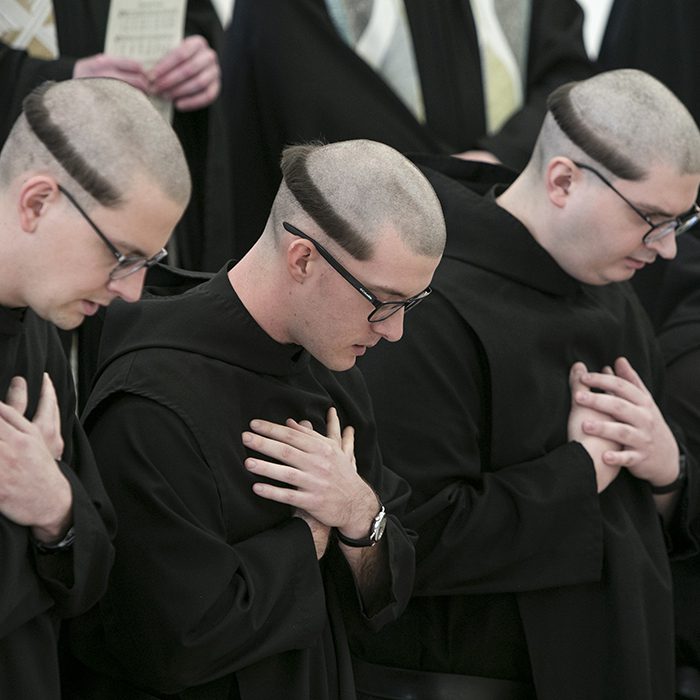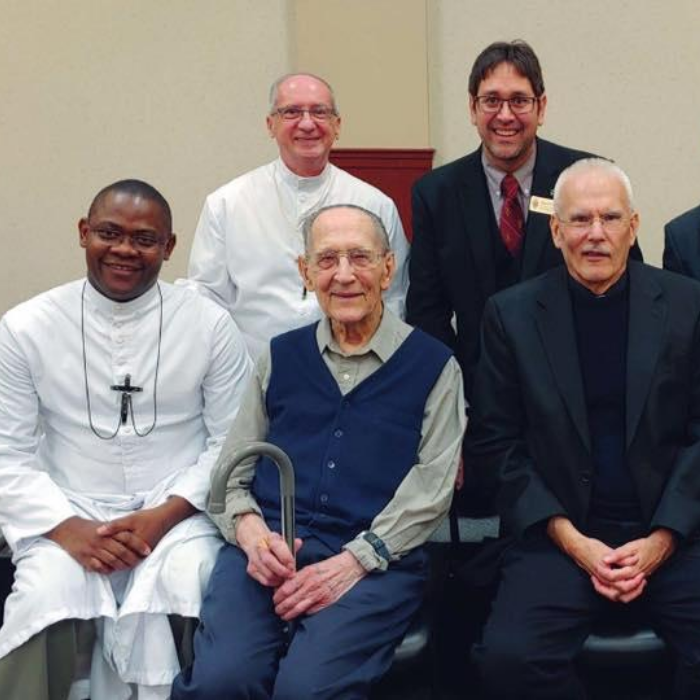Frequently Asked Questions About Religious Life
“The life consecrated through the profession of the evangelical counsels [chastity, poverty, and obedience] is a stable form of living by which the faithful, following Christ more closely under the action of the Holy Spirit, are totally dedicated to God who is loved most of all…” – Code of Canon Law, 573.1
“The religious state is a public and complete state of consecrated life….religious observe the three evangelical counsels of chastity, poverty, and obedience. They bind themselves to observe these by means of vows, which are either perpetual or temporary but renewed when they expire (can. 607.2). These vows are always public vows, i.e. recognized as such by the Church (can. 1192.1). This religious state requires fraternal life in community and also a degree of separation from the world in conformity with the character and purpose of the individual institute (can. 607.2 and 607.3).” Congregation for Institutes of Consecrated Life and Societies of Apostolic Life; See also Code of Canon Law, 607.2
A religious brother lives a life dedicated to service to others. This is a different vocation than that of a priest, a cleric, who is called to a sacramental life. “Lay institutes…participate in the pastoral function of the Church through spiritual and corporal works of mercy and offer the most diverse services to people.” – Code of Canon Law, 676
Each community of consecrated men has a particular charism, which is the spirit of the community and its mission. The charism shapes the way the members live, pray, work, and minister.
Apostolic: Consecrated men live together but perform a variety of ministries and services outside their home. Members of institutes with an apostolic charism may serve as teachers, doctors, or administrators, or work in parishes, schools, or any number of settings related to the mission of the institute. Examples include Redemptorists or Jesuits.
Contemplative: These communities focus less on outside ministry and more on a rhythmic life of prayer, community, and work. Men in contemplative communities usually have less contact with the outside world than those in apostolic or monastic communities. An example are the Trappists.
Mendicant: Mendicants, such as Carmelites, Dominicans, and Franciscans, rely on “begging” – on God’s providence – and live through the generosity of the faithful and their ministry. They came after monastics and gave up the stability of a monastery for “missionary zeal.”
Monastic: These communities place a high value on living and working together, but the members may also leave the monastery to perform ministries or tasks related to the life of the community. Some monastic communities operate a hospital or, as many Benedictines do, a school.
Religious priests are professed members of a religious order or institute. Religious clergy live according to the rule of their respective orders. In pastoral ministry, they are under the jurisdiction of their local bishop, as well as of the superiors of their order. Diocesan, or secular, priests are under the direction of their local bishop. Most serve in the parishes of the diocese, but they may also be assigned to other diocesan posts and ministries or be released for service outside the diocese. – United States Conference of Catholic Bishops
The clothing worn by a religious priest or brother depends on his community, their tradition, and his role.
- Habits. Some communities have a habit that is original or traditional. Examples include the black and white habits of the Dominicans or the brown habits of the Franciscans. Other communities wear habits which resemble clerical garb. In some communities the use of a habit is flexible depending on circumstances, or may be optional.
- Clerical clothing. In many men’s communities some, most, or even all, of the men may be involved with sacramental ministry, parish administration, or another aspect of Church life that makes clerical garb appropriate. In some mixed communities, lay religious Brothers may wear clothing that is often associated with ordained ministry.
- Casual clothing. Some communities of men find value in wearing clothing similar to those to whom they minister. Others wear clothing that reflects the culture in which they find themselves, while others find casual clothing is the most comfortable and practical option.
- Professional clothing. Many consecrated men are members of institutes in which professional standards of dress are consistent with the institute’s charism or mission. In fields of ministry such as business, education, medicine, or social services, consecrated men may wear clothing common to their area of expertise.
Formation programs and the length of formation vary based on the religious institute or congregation. The general stages of initial formation are:
- Postulancy: Live and pray with the religious community, learn about the community and religious life, and participate in aspects of the life of the community.
- Novitiate: Deepen knowledge of the order’s charism and spirituality, and the evangelical counsels of poverty, chastity and obedience.
- Temporary Vows: These are made at the end of the novitiate, with approval of the religious order. Temporary vows often are for 3-6 years and may be renewed.
- Perpetual Vows or Solemn Profession: This is a public declaration of an individual’s commitment and intention to give himself completely to God and in service to others though the charism of the order. This includes perpetual (lifelong) vows of poverty, chastity and obedience and may include additional vows specific to the order.
Clerics also are ordained transitional deacons and then priests. Formation does not end at final vows, but is lifelong.
Religious communities have great diversity in charisms. This makes them special, but can be challenging when discerning. One place to start is to consider if you are interested in mendicant, monastic, or apostolic and missionary communities. The specific charism of each religious community is essential in your discernment since the charism motivates the overall mission and purpose of a religious community.
A list of male religious in the United States is available here. The map includes links to the provinces, monasteries and abbeys that belong to CMSM, including website links. Another resource is the VISION Vocation Network, which has many resources to help you in your discernment process and to find a religious community that may be a good fit for you.





